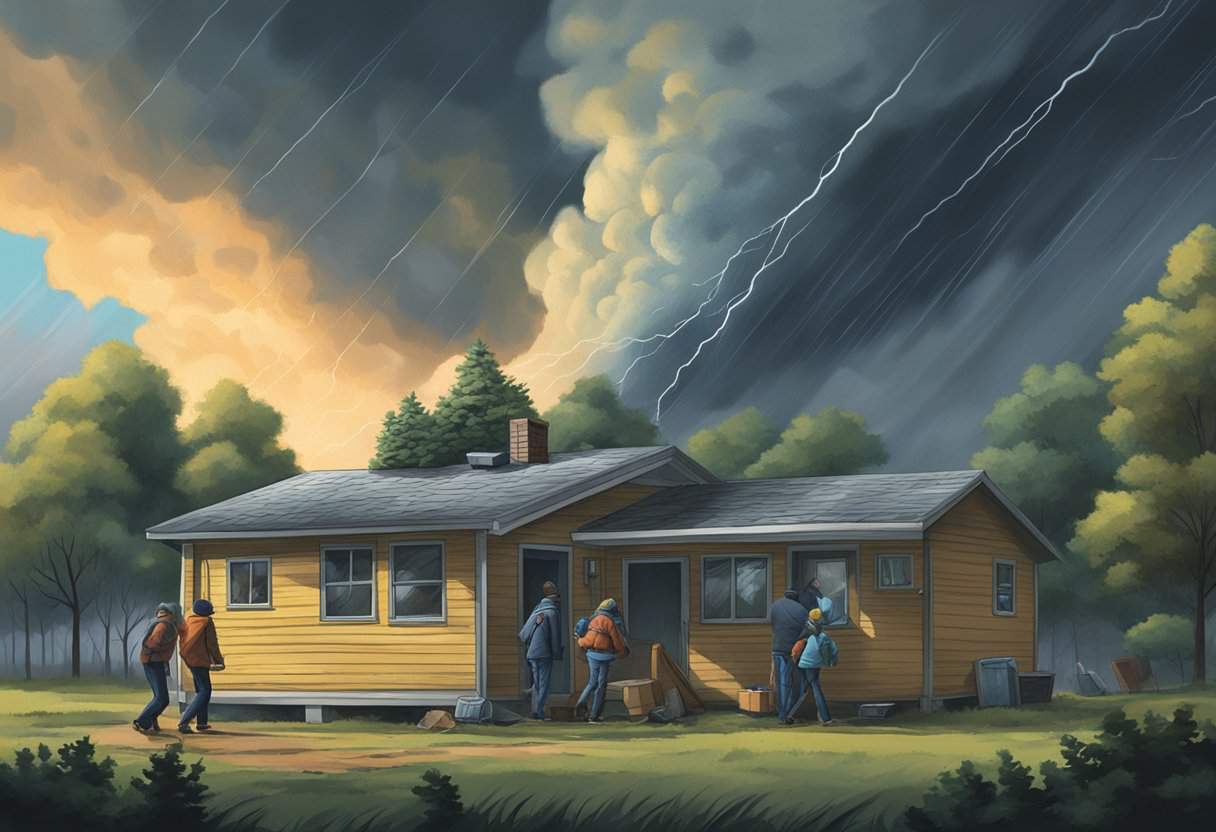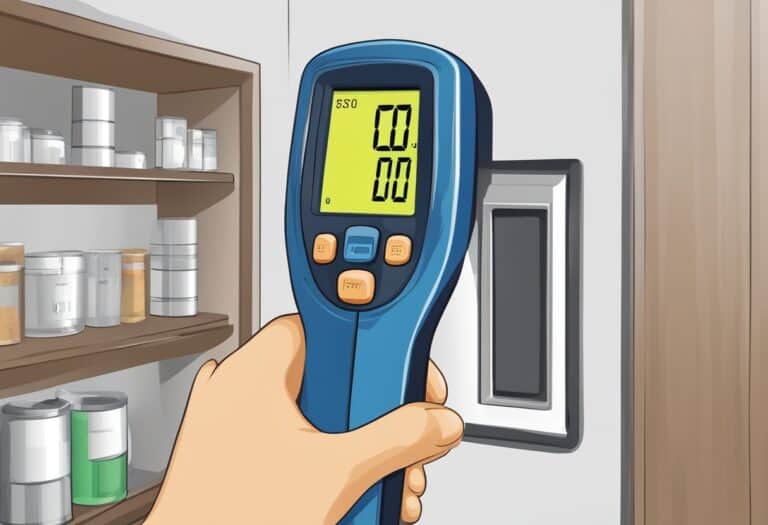Experiencing a severe storm can be a daunting and sometimes dangerous situation. It’s crucial for your safety to know what actions to take when skies turn threatening.
Whether you’re at home, on the road, or outdoors, being aware of the weather conditions and having a plan in place can significantly reduce the risks associated with severe storms. Understanding the signs of severe weather and implementing pre-storm preparations can help keep you and your loved ones safe.
During a severe storm, your immediate actions can have a profound impact on your well-being. Seeking shelter, staying informed through weather updates, and avoiding unnecessary travel are critical steps to minimize harm.
After a storm has passed, it is important to proceed with caution, as dangers such as downed power lines or structural damage may still pose threats. Special considerations should also be given to unique scenarios, such as being caught in a severe storm while in a vehicle or being responsible for a group of people.
Seek shelter indoors when storms threaten. Stay informed via weather alerts. If caught outside, avoid high ground and open areas. In cars, pull over and stay inside. After storms, be cautious of downed lines and report damage. Remember, your safety is paramount!
Understanding Severe Weather Conditions
Severe weather conditions pose significant risks, and understanding them is vital for your safety. Familiarizing yourself with the different types of severe storms and the National Weather Service’s (NWS) alert systems will help you prepare and respond appropriately.
Types of Severe Storms
Thunderstorms are common severe weather events that can lead to tornadoes, hurricanes, or hail. A thunderstorm is considered severe if it produces hail at least an inch in diameter or wind gusts over 58 miles per hour. Tornadoes are violently rotating columns of air extending from a storm to the ground and can destroy structures in their path. Hurricanes are tropical storms with sustained winds of at least 74 miles per hour and can cause widespread damage along coastlines and several hundred miles inland. Other severe conditions include blizzards, characterized by heavy snowfall and strong sustained winds of 35 miles per hour or more, leading to reduced visibility.
Weather Warnings and Watches
Understanding the difference between a weather warning and a weather watch is crucial. A warning means that severe weather is already occurring or will occur soon. For example, a tornado warning indicates a tornado has been sighted or indicated by weather radar, and immediate action is necessary for safety. A hurricane warning is issued when hurricane conditions are expected in a specified area. In contrast, a watch means that conditions are favorable for severe weather to develop but it’s not a certainty. For instance, a tornado watch suggests that tornadoes are possible in and near the watch area. Stay informed through a weather radio or online weather forecasts to receive timely weather warnings. The NWS will also issue special marine warnings for severe weather events affecting marine activity.
By remaining alert to weather forecasts and heedings from the National Weather Service, you can take preventative steps to safeguard yourself and your property from the threats posed by severe weather phenomena.
Pre-Storm Preparations
Effective pre-storm preparations can greatly enhance your safety and that of your property during severe weather. By securing your residence, assembling essential supplies, and crafting a clear safety plan, you equip yourself to weather the storm with resilience.
Securing Your Home or Building
To protect your shelter, ensure structural stability and minimize damage. Check and reinforce the security of windows and doors, as they are vulnerable to high winds and debris. Consider installing storm shutters or boarding up windows to guard against breakage. Secure or store outdoor items to prevent them from turning into projectiles. Regularly inspect the condition of your roof and foundation for potential weaknesses, and address any issues promptly.
Safety Kits and Emergency Supplies
Prepare a well-stocked safety kit that includes a first aid kit, essential medications, flashlights with extra batteries, and a battery-powered radio to stay informed. Store enough non-perishable food and water to last at least 72 hours for every member of your household, including pets. Make sure you have waterproof matches, a whistle to signal for help, and sturdy shoes for every family member. Keep this kit in a designated, easily accessible area.
Making a Safety Plan
Develop a family safety plan that includes evacuation routes and established emergency contact information. If you live in a tornado-prone area, identify the most secure room in your home, such as a basement or an inner hallway without windows, as your tornado survival shelter. Teach everyone in the household how to shut off utilities like power to prevent additional hazards. In case of hurricanes, determine the nearest official shelter and make a plan for a safe relocation if necessary. Practice your plan to ensure everyone understands their role and can perform it confidently.
Safety Measures During Storms

When a severe storm approaches, prioritizing your safety is crucial. Below are specific actions you can take to protect yourself during these events, focusing on finding shelter, ensuring safety indoors, and taking the right precautions if caught outdoors.
Finding Shelter
Locate a safe place immediately when a severe storm is imminent. If a tornado shelter is not available, a basement or an interior room without windows is the next best option. In the absence of a basement, a small, windowless space like a bathroom or closet on the lowest level of your home can provide protection, especially if you cover yourself with a mattress or heavy blankets.
Protecting Yourself Indoors
Should you find yourself indoors during a storm, avoid all windows and doors and stay clear of anything that conducts electricity. This includes avoiding use of wired electronics, plumbing, and disconnecting power cords before the storm to prevent damage from a lightning strike. It’s advisable to wear rubber gloves and remove any jewelry to reduce your risk of electrocution.
| If You Hear Thunder |
|---|
| It’s safe to assume lightning is nearby. You should not use landline phones or appliances and consider unplugging all electrical equipment. |
Staying Safe Outdoors
In the event you’re caught outside during a severe storm, avoid high ground, isolated trees, and water. Never shelter under a highway overpass, as winds can be stronger and more dangerous in these areas. If you’re in your car, pull over, keep your seatbelt on, and position your steering wheel away from you to minimize injury from potential airbag deployment. If a tornado is visible, find a low, flat location, cover your head with your arms, and, if possible, with a helmet to protect against debris.
Post-Storm Safety and Recovery
After a severe storm passes, ensuring your safety and effectively recovering are paramount. Addressing injuries, assessing damages, coordinating with authorities, and cautiously navigating the aftermath should be your immediate focus.
Handling Injuries and Damages
If you or anyone with you has sustained an injury, promptly administer first aid using your first aid kit while awaiting professional medical assistance. For injuries beyond minor cuts and abrasions, seek medical attention as soon as conditions allow.
Inspect your property for damages cautiously; hidden dangers may exist. Prioritize your safety by wearing sturdy shoes and gloves to protect against debris. If your residence is damaged, shut off utilities to prevent further incidents and only use flashlights to avoid sparks from damaged electrical systems.
Reporting to Authorities
After ensuring personal safety, it’s crucial to report damages to the appropriate authorities. Contact the National Weather Service and local emergency services to report severe weather-related incidents and receive guidance. They can also provide recovery resources and instructions for clean-up and repairs.
Remain informed with updates from officials and heed their safety tips to avoid the hazards of weakened structures, downed power lines, and possible gas leaks. Documenting the damage thoroughly can assist in insurance claims and can be beneficial to emergency services for assessing the overall impact of the storm.
Special Considerations for Specific Scenarios
When confronted with severe storm conditions, your immediate actions can greatly influence your safety and the safety of those around you. The following advice is tailored to different scenarios where storms may pose significant risks.
Severe Storms While Boating
In the event of severe weather while boating, prioritize safety by wearing life jackets and securing loose objects. It is critical to turn off all electrical equipment and stow away power cords to prevent electrical hazards. If in open boats, retreat to shore if possible before visibility decreases. Also, ensure that your navigation lights are on and that you keep communication open using a VHF radio. Avoid being in contact with metal steering wheels or any other metal surfaces during a storm.
Severe Storms While Driving
While driving, if you encounter high winds or a severe storm, your best course of action is to slow down and maintain a safe distance from other vehicles. If necessary, seek shelter in a sturdy building but avoid parking under highway overpasses, as these can create deadly wind funnels. Never attempt to outrun a tornado; instead, seek a low-lying area and protect yourself from potential flying debris. Keeping a safety kit in your car can also be invaluable in unexpected severe weather conditions.
Employer’s Responsibilities to Employees
During a severe storm, employers have the responsibility to ensure the safety of their employees. It is crucial to have an emergency plan in place and communicate it clearly to all workers. For outdoor work, monitor for signs of bad weather and have a protocol for securing gear and machinery. Ensure that all employees know the location of the designated shelter and understand safety tips related to specific tasks they might be engaged in during a severe storm.
Frequently Asked Questions
When you’re faced with severe storm conditions, it’s critical to have a clear understanding of the safety measures to take. These frequently asked questions cover the actions you should consider to protect yourself and others during such events.
How can you ensure safety when a thunderstorm is approaching?
Monitor weather updates closely and seek shelter immediately, preferably in a building or a car. Stay away from windows, electrical equipment, and plumbing. It’s essential to avoid high ground, open spaces, and all metal objects including fences and poles.
What steps should be taken during a severe thunderstorm warning?
During a severe thunderstorm warning, head indoors and move to the lowest floor of your building, away from glass windows and doors. Secure any loose objects outside that could become projectile and if you’re in a vehicle, park safely and stay inside.
In the event of a storm and your boat’s engine fails, what actions should you take?
If your boat’s engine fails, immediately put on a life jacket and ensure all passengers do the same. Try to anchor the boat if possible, and use distress signals to call for help. Remain as low in the boat as you can to minimize the risk of being thrown overboard by waves or wind.
What are the recommended severe weather safety practices while at work?
Identify the designated shelter areas at your workplace. Participate in regular severe weather drills and be aware of how to shut down operations if necessary. Keep an emergency kit accessible at your work area that includes basic supplies and a first aid kit.
During a storm, what safety measures should someone take?
If you are unable to shelter in a building, find a low spot away from trees, fences, and poles to reduce the risk of lightning strikes. Cover your head with your arms and crouch down to make yourself less of a target for lightning.
What general precautions are advised for someone caught in a severe storm?
Remain calm and avoid panicking. Stay informed through a weather radio or online sources. Keep clear of downed power lines and report them to authorities. If you’re driving, pull over and park, keeping your seat belt on and engine running to maintain airbags functionality.







